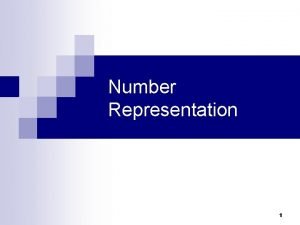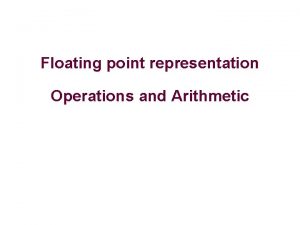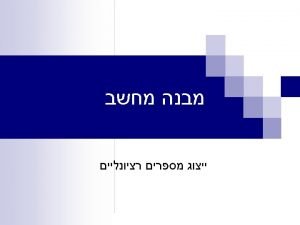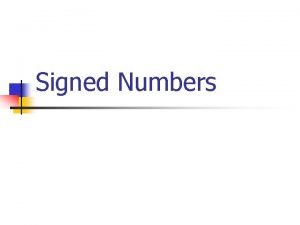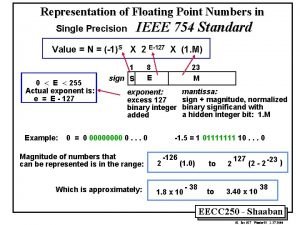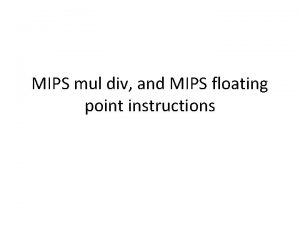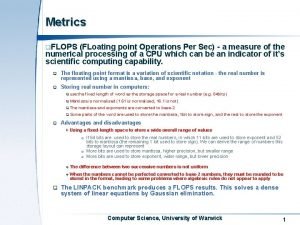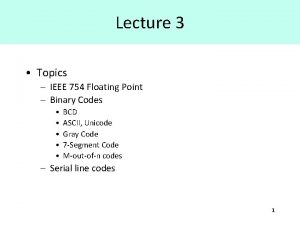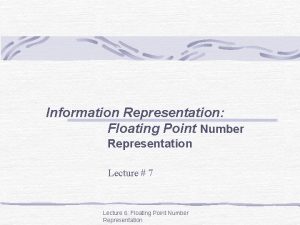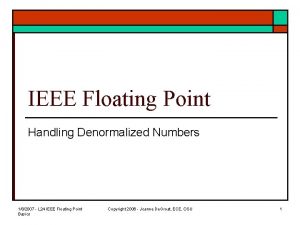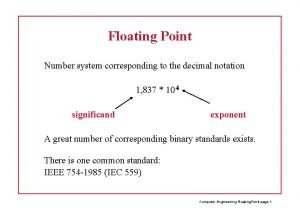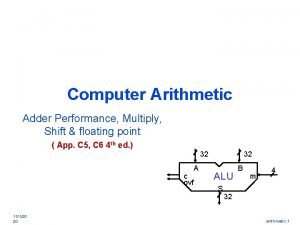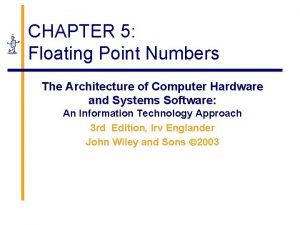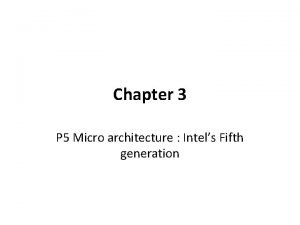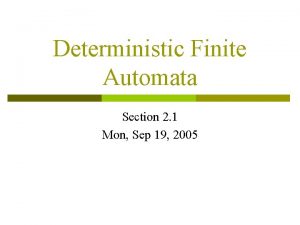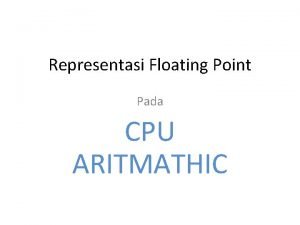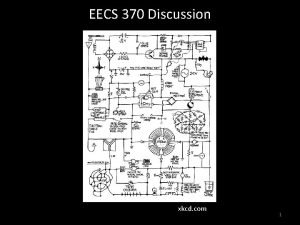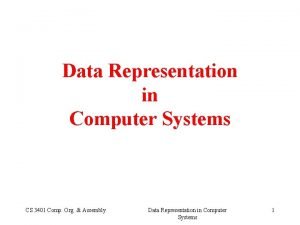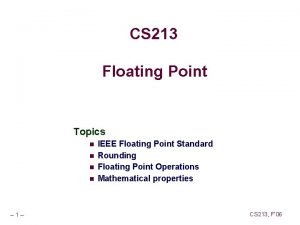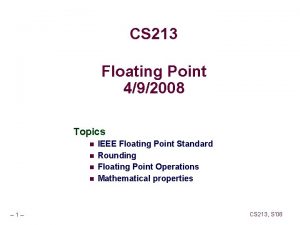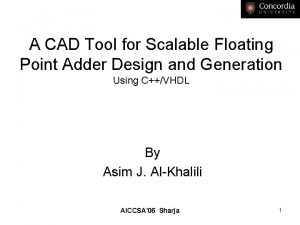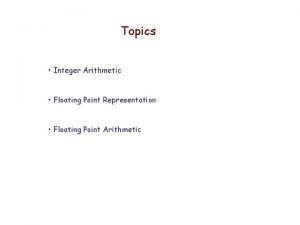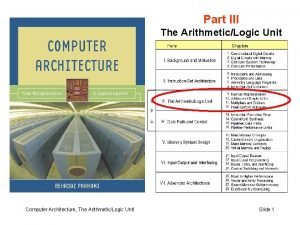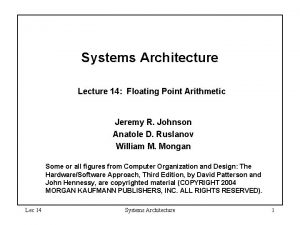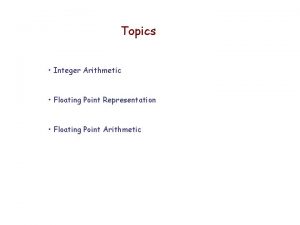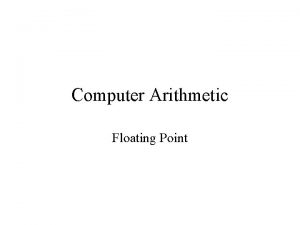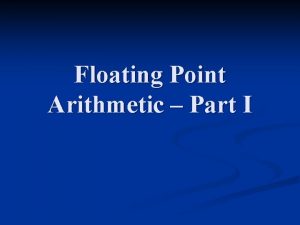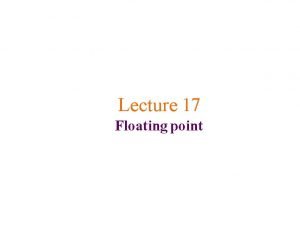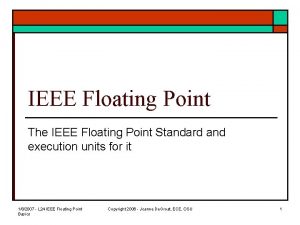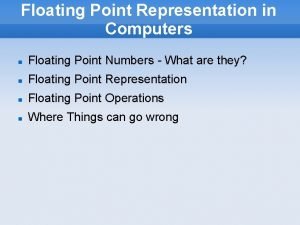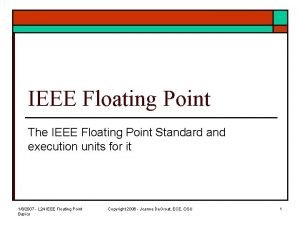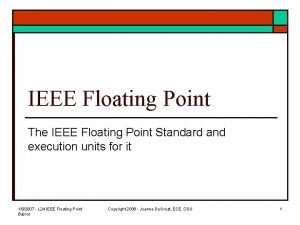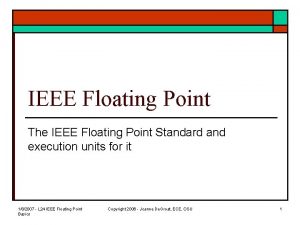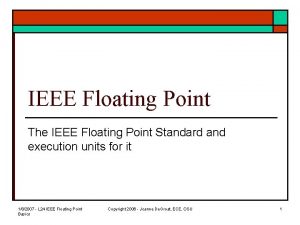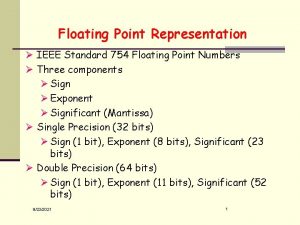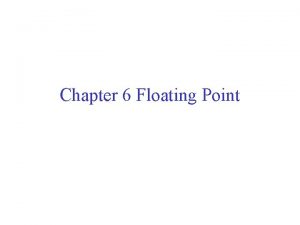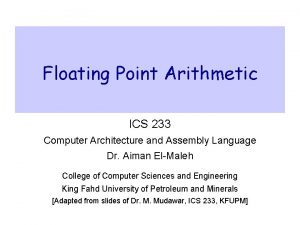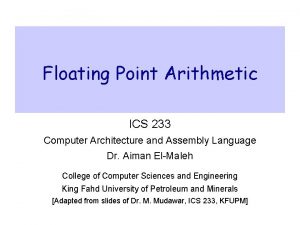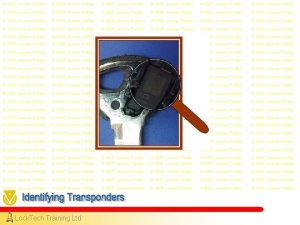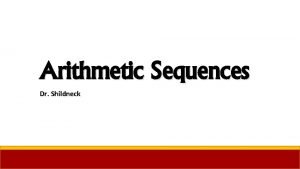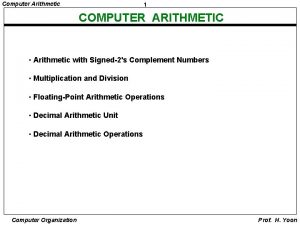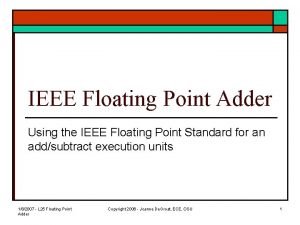Systems Architecture Lecture 14 Floating Point Arithmetic Jeremy


































- Slides: 34

Systems Architecture Lecture 14: Floating Point Arithmetic Jeremy R. Johnson Anatole D. Ruslanov William M. Mongan Some or all figures from Computer Organization and Design: The Hardware/Software Approach, Third Edition, by David Patterson and John Hennessy, are copyrighted material (COPYRIGHT 2004 MORGAN KAUFMANN PUBLISHERS, INC. ALL RIGHTS RESERVED). Lec 14 Systems Architecture 1

Introduction • Objective: To provide hardware support for floating point arithmetic. To understand how to represent floating point numbers in the computer and how to perform arithmetic with them. Also to learn how to use floating point arithmetic in MIPS. • Approximate arithmetic – Finite Range – Limited Precision • Topics – IEEE format for single and double precision floating point numbers – Floating point addition and multiplication – Support for floating point computation in MIPS Lec 14 Systems Architecture 2

Distribution of Floating Point Numbers • 3 bit mantissa • exponent {-1, 0, 1} 0 Lec 14 1 2 Systems Architecture 3 3

Floating Point • An IEEE floating point representation consists of – A Sign Bit (no surprise) – An Exponent (“times 2 to the what? ”) – Mantissa (“Significand”), which is assumed to be 1. xxxxx (thus, one bit of the mantissa is implied as 1) – This is called a normalized representation • So a mantissa = 0 really is interpreted to be 1. 0, and a mantissa of all 1111 is interpreted to be 1. 1111 • Special cases are used to represent denormalized mantissas (true mantissa = 0), Na. N, etc. , as will be discussed. Lec 14 Systems Architecture 4

Floating Point Standard • Defined by IEEE Std 754 -1985 • Developed in response to divergence of representations – Portability issues for scientific code • Now almost universally adopted • Two representations – Single precision (32 -bit) – Double precision (64 -bit) Lec 14 Systems Architecture 5

IEEE Floating-Point Format single: 8 bits double: 11 bits single: 23 bits double: 52 bits S Exponent Fraction • S: sign bit (0 non-negative, 1 negative) • Normalize significand: 1. 0 ≤ |significand| < 2. 0 – Always has a leading pre-binary-point 1 bit, so no need to represent it explicitly (hidden bit) – Significand is Fraction with the “ 1. ” restored • Exponent: excess representation: actual exponent + Bias – Ensures exponent is unsigned – Single: Bias = 127; Double: Bias = 1203 Lec 14 Systems Architecture 6

Single-Precision Range • Exponents 0000 and 1111 reserved • Smallest value – Exponent: 00000001 actual exponent = 1 – 127 = – 126 – Fraction: 000… 00 significand = 1. 0 – ± 1. 0 × 2– 126 ≈ ± 1. 2 × 10– 38 • Largest value – exponent: 11111110 actual exponent = 254 – 127 = +127 – Fraction: 111… 11 significand ≈ 2. 0 – ± 2. 0 × 2+127 ≈ ± 3. 4 × 10+38 Lec 14 Systems Architecture 7

Double-Precision Range • Exponents 0000… 00 and 1111… 11 reserved • Smallest value – Exponent: 000001 actual exponent = 1 – 1023 = – 1022 – Fraction: 000… 00 significand = 1. 0 – ± 1. 0 × 2– 1022 ≈ ± 2. 2 × 10– 308 • Largest value – Exponent: 111110 actual exponent = 2046 – 1023 = +1023 – Fraction: 111… 11 significand ≈ 2. 0 – ± 2. 0 × 2+1023 ≈ ± 1. 8 × 10+308 Lec 14 Systems Architecture 8

Representation of Floating Point Numbers • IEEE 754 single precision 31 30 Sign 23 22 Biased exponent 0 Normalized Mantissa (implicit 24 th bit = 1) (-1)s F 2 E-127 Lec 14 Systems Architecture 9

Why biased exponent? • For faster comparisons (for sorting, etc. ), allow integer comparisons of floating point numbers: • Unbiased exponent: 1/2 0 1111 0000 0000 2 0 0001 0000 0000 • Biased exponent: 1/2 0 0111 1110 0000 0000 2 0 1000 0000 0000 Lec 14 Systems Architecture 10

Basic Technique • Represent the decimal in the form +/- 1. xxxb x 2 y • And “fill in the fields” – Remember biased exponent and implicit “ 1. ” mantissa! • Examples: – – – – Lec 14 0. 0: 0 000000000000000 1. 0 (1. 0 x 2^0): 0 01111111 000000000000 0. 5 (0. 1 binary = 1. 0 x 2^-1): 0 01111110 000000000000 0. 75 (0. 11 binary = 1. 1 x 2^-1): 0 01111110 100000000000 3. 0 (11 binary = 1. 1*2^1): 0 100000000000000 -0. 375 (-0. 011 binary = -1. 1*2^-2): 1 01111101 100000000000 1 10000011 0100000000000 = - 1. 01 * 2^4 = -20. 0 Systems Architecture http: //www. math-cs. gordon. edu/courses/cs 311/lectures-2003/binary. html Copyright © 2003 - Russell C. Bjork 11

Basic Technique • One can compute the mantissa just similar to the way one would convert decimal whole numbers to binary. • Take the decimal and repeatedly multiply the fractional component by 2. The whole number portion is the next binary bit. • For whole numbers, append the binary whole number to the mantissa and shift the exponent until the mantissa is in normalized form. Lec 14 Systems Architecture http: //www. newton. dep. anl. gov/newton/askasci/1995/math/MATH 065. HTM 12

Floating-Point Example • Represent – 0. 75 – – 0. 75 = (– 1)1 × 1. 12 × 2– 1 – S=1 – Fraction = 1000… 002 – Exponent = – 1 + Bias • Single: – 1 + 127 = 126 = 011111102 • Double: – 1 + 1023 = 1022 = 01111102 • Single: 1011111101000… 00 • Double: 101111101000… 00 Lec 14 Systems Architecture 13

Floating-Point Example • What number is represented by the single-precision float 11000000101000… 00 – S=1 – Fraction = 01000… 002 – Fxponent = 100000012 = 129 • x = (– 1)1 × (1 + 012) × 2(129 – 127) = (– 1) × 1. 25 × 22 = – 5. 0 Lec 14 Systems Architecture 14

Representation of Floating Point Numbers • IEEE 754 double precision 31 30 Sign 20 19 Biased exponent 0 Normalized Mantissa (implicit 53 rd bit) (-1)s F 2 E-1023 Lec 14 Systems Architecture 17

Floating Point Arithmetic • fl(x) = nearest floating point number to x • Relative error (precision = s digits) –|x - fl(x)|/|x| 1/2 1 -s for = 2, 2 -s • Arithmetic –x y = fl(x+y) = (x + y)(1 + ) –x y = fl(x y)(1 + ) for < u ULP—Unit in the Last Place is the smallest possible increment or decrement that can be made using the machine's FP arithmetic. Lec 14 Systems Architecture 18

Floating-Point Precision • Relative precision – all fraction bits are significant – Single: approx 2– 23 • Equivalent to 23 × log 102 ≈ 23 × 0. 3 ≈ 6 decimal digits of precision – Double: approx 2– 52 • Equivalent to 52 × log 102 ≈ 52 × 0. 3 ≈ 16 decimal digits of precision Lec 14 Systems Architecture 19

Is FP addition associative? • Associativity law for addition: a + (b + c) = (a + b) + c • Let a = – 2. 7 x 1023, b = 2. 7 x 1023, and c = 1. 0 • a + (b + c) = – 2. 7 x 1023 + ( 2. 7 x 1023 + 1. 0 ) = – 2. 7 x 1023 + 2. 7 x 1023 = 0. 0 • (a + b) + c = ( – 2. 7 x 1023 + 2. 7 x 1023 ) + 1. 0 = 0. 0 + 1. 0 = 1. 0 • Beware – Floating Point addition not associative! • The result is approximate… • Why the smaller number disappeared? Lec 14 Systems Architecture 20

Floating point addition • Lec 14 Systems Architecture 21

Floating-Point Addition • Consider a 4 -digit decimal example – 9. 999 × 101 + 1. 610 × 10– 1 • 1. Align decimal points – Shift number with smaller exponent – 9. 999 × 101 + 0. 016 × 101 • 2. Add significands – 9. 999 × 101 + 0. 016 × 101 = 10. 015 × 101 • 3. Normalize result & check for over/underflow – 1. 0015 × 102 • 4. Round and renormalize if necessary – 1. 002 × 102 Lec 14 Systems Architecture 22

Floating-Point Addition • Now consider a 4 -digit binary example – 1. 0002 × 2– 1 + – 1. 1102 × 2– 2 (0. 5 + – 0. 4375) • 1. Align binary points – Shift number with smaller exponent – 1. 0002 × 2– 1 + – 0. 1112 × 2– 1 • 2. Add significands – 1. 0002 × 2– 1 + – 0. 1112 × 2– 1 = 0. 0012 × 2– 1 • 3. Normalize result & check for over/underflow – 1. 0002 × 2– 4, with no over/underflow • 4. Round and renormalize if necessary – 1. 0002 × 2– 4 (no change) = 0. 0625 Lec 14 Systems Architecture 23

FP Adder Hardware • Much more complex than integer adder • Doing it in one clock cycle would take too long – Much longer than integer operations – Slower clock would penalize all instructions • FP adder usually takes several cycles – Can be pipelined Lec 14 Systems Architecture 24

FP Adder Hardware Step 1 Step 2 Step 3 Step 4 Lec 14 Systems Architecture 25

Floating Point Multiplication Algorithm Lec 14 Systems Architecture 26

FP Arithmetic Hardware • FP multiplier is of similar complexity to FP adder – But uses a multiplier for significands instead of an adder • FP arithmetic hardware usually does – Addition, subtraction, multiplication, division, reciprocal, square-root – FP integer conversion • Operations usually takes several cycles – Can be pipelined Lec 14 Systems Architecture 29

FP Instructions in MIPS • FP hardware is coprocessor 1 – Adjunct processor that extends the ISA • Separate FP registers – 32 single-precision: $f 0, $f 1, … $f 31 – Paired for double-precision: $f 0/$f 1, $f 2/$f 3, … • Release 2 of MIPs ISA supports 32 × 64 -bit FP reg’s • FP instructions operate only on FP registers – Programs generally don’t do integer ops on FP data, or vice versa – More registers with minimal code-size impact • FP load and store instructions – lwc 1, ldc 1, swc 1, sdc 1 • e. g. , ldc 1 $f 8, 32($sp) Lec 14 Systems Architecture 30

FP Instructions in MIPS • Single-precision arithmetic – add. s, sub. s, mul. s, div. s • e. g. , add. s $f 0, $f 1, $f 6 • Double-precision arithmetic – add. d, sub. d, mul. d, div. d • e. g. , mul. d $f 4, $f 6 • Single- and double-precision comparison – c. xx. s, c. xx. d (xx is eq, lt, le, …) – Sets or clears FP condition-code bit • e. g. c. lt. s $f 3, $f 4 • Branch on FP condition code true or false – bc 1 t, bc 1 f • e. g. , bc 1 t Target. Label Lec 14 Systems Architecture 31

FP Example: °F to °C • C code: float f 2 c (float fahr) { return ((5. 0/9. 0)*(fahr - 32. 0)); } – fahr in $f 12, result in $f 0, literals in global memory space • Compiled MIPS code: f 2 c: lwc 1 lwc 2 div. s lwc 1 sub. s mul. s jr Lec 14 $f 16, $f 18, $f 0, $ra const 5($gp) const 9($gp) $f 16, $f 18 const 32($gp) $f 12, $f 18 $f 16, $f 18 Systems Architecture 32

Rounding • Guard and round digits and sticky bit – When computing result, assume there are several extra digits available for shifting and computation. This improves accuracy of computation. – Guard digit: first extra digit/bit to the right of mantissa -- used for rounding addition results – Round digit: second extra digit/bit to the right of mantissa -- used for rounding multiplication results – Sticky bit: third extra digit/bit to the right of mantissa – used for resolving ties such as 0. 50. . . 00 vs. 0. 50. . . 01 Lec 14 Systems Architecture 33

Rounding examples • An example without guard and round digits – Add 9. 76 x 1025 and 2. 59 x 1024 assuming 3 digit mantissa • Shift mantissa of the smaller number to the right: 0. 25 x 1025 • Add mantissas: 10. 01 x 1025 • Check and normalize mantissa if necessary: 1. 00 x 1026 • An example with guard and round digits – Add 9. 76 x 1025 and 2. 59 x 1024 assuming 3 digit mantissa • • • Lec 14 Internal registers have extra two digits: 9. 7600 x 1025 and 2. 5900 x 1024 Shift mantissa of the smaller number to the right: 0. 2590 x 1025 Add mantissas: 10. 0190 x 1025 Check and normalize mantissa if necessary: 1. 0019 x 1026 Round the result: 1. 00 x 1026 Systems Architecture 34

Rounding examples • An example without guard and round digits – Add 9. 78 x 1025 and 8. 79 x 1024 assuming 3 digit mantissa • Shift mantissa of the smaller number to the right: 0. 87 x 1025 • Add mantissas: 10. 65 x 1025 • Normalize mantissa if necessary: 1. 06 x 1026 • An example with guard and round digits – Add 9. 78 x 1025 and 8. 79 x 1024 assuming 3 digit mantissa • • • Lec 14 Internal registers have extra two digits: 9. 7800 x 1025 and 8. 7900 x 1024 Shift mantissa of the smaller number to the right: 0. 8790 x 1025 Add mantissas (note extra digit on the left): 10. 6590 x 1025 Check and normalize mantissa if necessary: 1. 0659 x 1026 Round the result: 1. 07 x 1026 Systems Architecture 35

IEEE Rounding Modes 1. 2. 3. 4. Round toward – Infinity: always round toward the smaller number Round toward + Infinity: always round toward the larger number Round to Zero: always round toward the smallest absolute (truncate) Round toward Nearest Even: always round so that least significant bit (lsb) is zero 1. 40 1. 60 1. 50 2. 50 – 1. 50 Zero 1. 00 2. 00 Nearest Even (default) 1. 00 2. 00 • • 2. 00 3. 00 – 1. 00 – 2. 00 – 1. 00 2. 00 – 2. 00 When rounding a binary fraction, the least significant digit of rounded result will be either 1 or 0. Nearest even mode always rounds the number so that the lsb is 0. Hence, the name. (If we omit the binary point, the rounded number would be even. ) It can be shown that if we assume uniform distribution of digits, rounding to nearest mode tends to have mean error = 0. Lec 14 Systems Architecture 36

FP Instructions in MIPS • Floating point operations are slower than integer operations • Data is rarely converted from integers to float within the same procedure • 1980’s solution – place FP processing unit in a separate chip • Today’s solution – imbed FP processing unit in processor chip • Co-processor 1 features: – Contains 32 single precision floating point registers: $f 0, $f 1, … $f 31 – These registers can also act as 16 double precision registers: $f 0/$f 1, $f 2/$f 3, … , $f 30/$f 31 (only the first one is specified in the instructions) – Uses special floating point instructions, which are similar (in format) to integer instructions but have. s or. d attached to signify that they work on fp numbers – Several special instructions to move between “regular” registers and the coprocessor registers Lec 14 Systems Architecture 37

FP Instructions in MIPS • lwc 1 / swc 1 – load/store word coprocessor 1 • Move instructions (between processors) mfc 1 rt, rd Move floating point register rd to CPU register rt mtc 1 rd, rt Move CPU register rt to floating point register rd mfc 1. d rdest, frsrc 1 Move frsrc 1 & frsrc 1 + 1 to regs rdest & rdest + 1 • Single and double precision arithmetic instructions Single add. s, sub. s, mul. s, div. s, c. lt. s Double add. d, sub. d, mul. d, div. d, c. lt. d • Examples: Lec 14 add. s $f 0, $f 1, $f 2 Systems Architecture sub. d $f 0, $f 2, $f 4 38
 Explain floating point arithmetic operations with example
Explain floating point arithmetic operations with example Floating point arithmetic examples
Floating point arithmetic examples Hola quién soy yo
Hola quién soy yo Fp adder
Fp adder Fixed point representation
Fixed point representation 01:640:244 lecture notes - lecture 15: plat, idah, farad
01:640:244 lecture notes - lecture 15: plat, idah, farad Convert to floating point
Convert to floating point Floating point multiplication flowchart
Floating point multiplication flowchart Mips mul instruction
Mips mul instruction Bit4bytes
Bit4bytes Ieee 754 floating point
Ieee 754 floating point Why use floating point numbers
Why use floating point numbers Floating point denormalized
Floating point denormalized Floating point representation
Floating point representation Floating-point number
Floating-point number Shift and add multiplication
Shift and add multiplication Parts of a floating point number
Parts of a floating point number Parts of a floating point number
Parts of a floating point number Pentium pipeline stages
Pentium pipeline stages Xkcd floating point
Xkcd floating point Dfa for floating point numbers
Dfa for floating point numbers Representasi floating point
Representasi floating point Www.xkcd.com
Www.xkcd.com Express (32)10 in the revised 14-bit floating-point model.
Express (32)10 in the revised 14-bit floating-point model. Floating point form
Floating point form Floating point puzzles
Floating point puzzles Floating point puzzles
Floating point puzzles Compound adder
Compound adder Floating point division
Floating point division 4 bit two's complement
4 bit two's complement Computer architecture notes
Computer architecture notes Isa definition computer
Isa definition computer Advanced operating system notes
Advanced operating system notes Lecture sound systems
Lecture sound systems Lecture sound systems
Lecture sound systems
